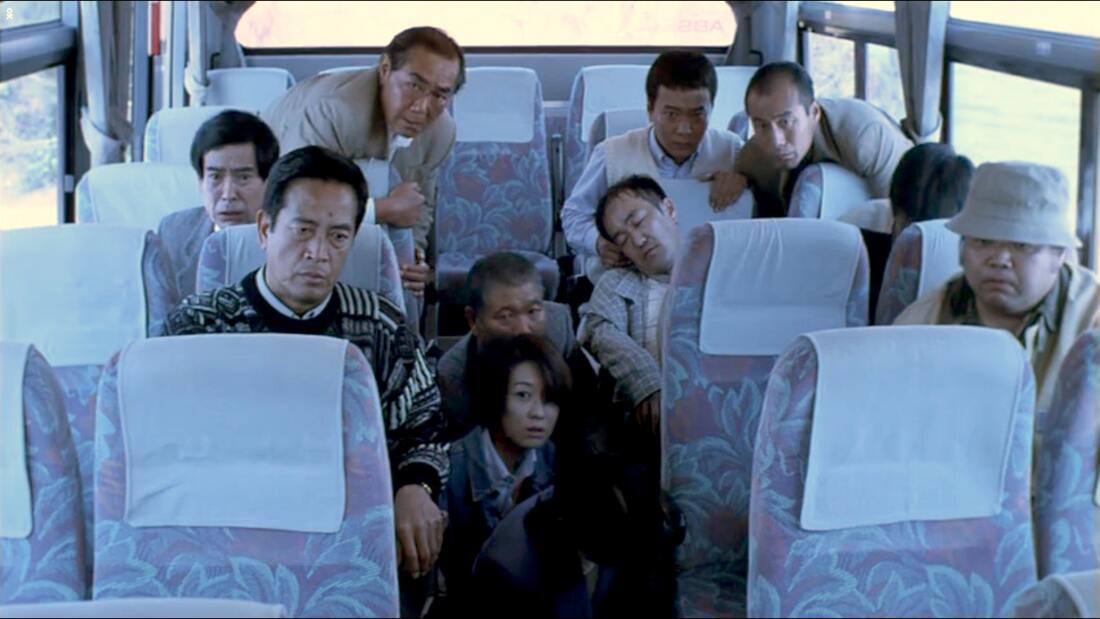
Love, Thy Name Be Sorrow is based on a Japanese folktale. It is not a hero’s journey but Joseph Campbell would recognize the narrative elements involving mistaken identity, a trickster spirit, and tragic fatalism. The story is rich and engrossing and centers around the Japanese staple conflict between duty and romance, or protocol and passion, but it is not the narrative that makes Love, Thy Name Be Sorrow remarkable, it is its visual style.
It is not the cinematography per-say, but the look and feel of the entire production. Love, Thy Name Be Sorrow belongs to a group of Japanese films that mix different modes of storytelling. Films such as The Ballad of Narayana, Kwaidan and, Jigoku. All of these films mix realism with Noh, Kabuki, and Butoh. They move fluidly along a spectrum of artifice where at one end they are shot on location with lifelike naturalism, and at the other end are shot in front of a curtain on a soundstage with two-dimensional sets, stylized masks, theatrical lighting, and mannered expressionistic movements.

It can be jarring at first to move back and forth between such disparate poles. There is a scene in Love, Thy Name Be Sorrow where Yasuna, the protagonist, goes to a gravesite to mourn the death of his wife. The scene begins on location in a field somewhere, but then the point of view switches from behind Yasuna who is facing the graves to in front of Yasuna which reveals behind him a highly styled, supersaturated field of yellow flowers against an equally yellow sky. Then the whole scene changes to a Butoh dance with a fan and mournful music ending with Yasuna collapsing in a heap on the ground. The camera zooms in to a medium shot of Yasuna lying in the field and then suddenly the sky ripples and falls away. We knew the sky was artificial but it is still a shock to see this enormous yellow backdrop billow away and reveal the outdoor location for the next scene.

In another transition later in the film, a scene ends and the movie cuts to a theater proscenium. Then just as you are recognizing what it is a hand grasps the curtain and pulls it aside revealing the next scene.

The different modes of delivery in Love, Thy Name Be Sorrow feel like layers of reality. The more abstracted the delivery the more it feels like a meta-story. Folktales occupy a space similar to myths. They may not have actually happened but they contain a kind of veracity because they resonate. When we first hear them as children we easily slide between truth and fiction. As we get older we understand that the stories aren’t true but since we were first exposed to them as children they have a special status. After all who would believe the stories in the Bible if the stories hadn’t been presented to them when they were children. When we are children the stories seem true but as adults, we remember the stories because they contain truth.
In Love, Thy Name Be Sorrow most of the characters are normal human beings that we can identify with but they must deal with a dangerous trickster fox spirit. The presence of magic distances us from the story but our need to suspend disbelief is lessened by the fact that the fox spirit or yokai can transform herself into a human. We can forget or set aside the magic when she is in human form. The fact that she is a yokai becomes a dangerous secret that drives the tension of the film instead of a weird magical conceit that must be allowed for. At every turn, the film plays upon different levels of abstraction. When the yokai is alone or in private the audience sees an actress wearing a traditional, wooden, noh mask of a fox, but when she interacts with the other characters she appears as human.

As a whole, the intense beauty of the film feels like another level of abstraction in and of itself. We can follow the plot but the saturated colors, the beautiful kimonos, the lighting, the various textures, and temperatures make each moment into a painting. There is a sense of timelessness as you encounter these lush visions. It all folds back into the duality of a folktale that is both a product of a specific time and place as well as a timeless vehicle for universal expressions.

The director Tomu Uchida does not make a habit of working this way. No doubt He adopted this style because of the nature of the content. Tomu Uchida is better known for his movie Tsuchi (also known as Earth or The Naked Island) which he made in 1939. It’s a sparse and stoic film about the trials of a farming family. It has a strong socialist message along the lines of an Italian neorealist film. As such it is filmed in stark, high-contrast black and white which is far more appropriate to the content than luxurious fabrics, and bright yellow skies.
In his long career, Uchida managed to work in many different styles. His film The Bloody Spear At Mount Fuji presents similar socialist ideas but conveys them through a chanbara (swordplay film) instead. He studied under Mizoguchi in the twenties during the silent era. Uchida is not as well known in the West as he is in Japan but he made 70 films before he died in 1970.

www.filmofileshideout.com/archives/two-film-adaptions-of-botan-doro-japans-favorite-ghost-storyIf you enjoyed this article click here for more



